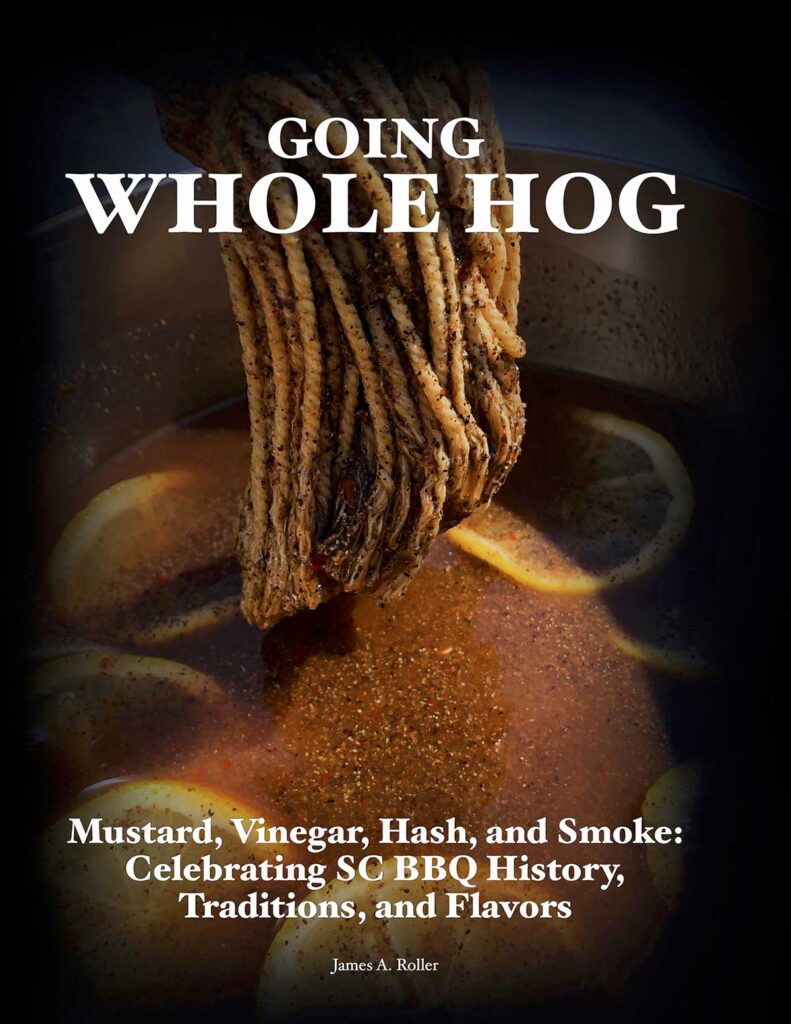Why I Love SC BBQ Hash
South Carolina barbecue hash.
If you’re from South Carolina, you know what I’m talking about. If you’re from anywhere else, you probably only think you do.
Like mustard-based BBQ sauce, hash is unique to our state, having originated here and having become a staple in BBQ joints across the state.
While the “hash houses” of old have all but disappeared and despite an influx of outside influences bringing other barbecue traditions into our state, hash remains an expectation among true South Carolina BBQ aficionados.
Hash, however, has not really spilled across our borders. Sure, it can be found in a few random spots in both Georgia and North Carolina, but even there few have even heard of hash.
Often, however, those places are not far from the state line and tend to have underlying South Carolina connections.
For instance, Elliot Moss used to sell hash at the former Buxton Hall BBQ in Asheville, NC. In Georgia, Bryan Furman offered “Hash and Rice” on his menu at B’s Cracklin’ BBQ in Atlanta and Savannah (both locations burned in separate incidences).
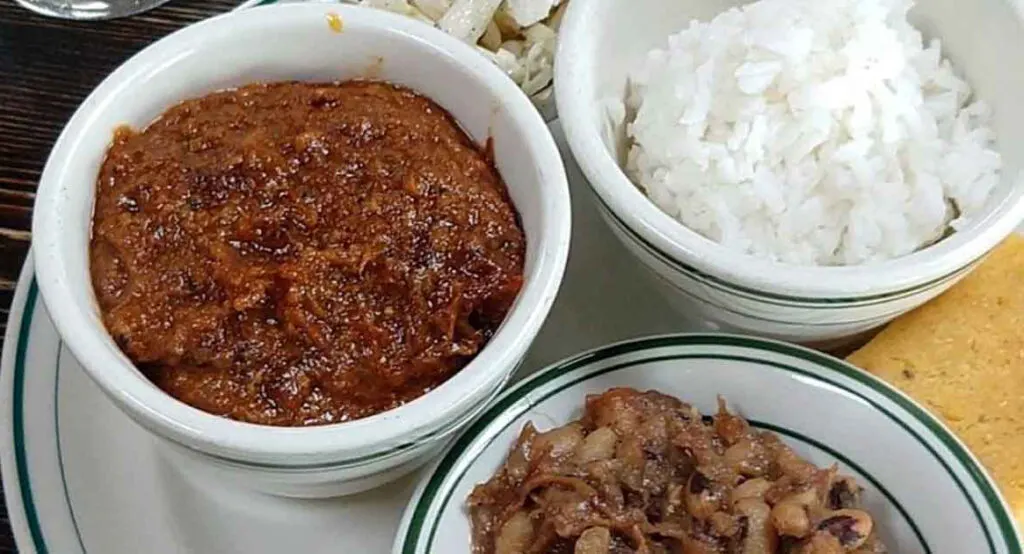
The thing is, Moss and Furman are both from South Carolina.
Moss grew up in Florence, and Furman spent his childhood in Cassatt living on his grandparent’s farm. They make their hash in our barbecue tradition. So, even when you find hash served over rice or bread in places other than South Carolina, there is often a true SC connection.
What is it Anyway?
If you’ve read this far without knowing what I’m talking about, let me explain.
Trying hash for the first time, writer, historian (and native Louisianan) Rien Fertel shared his first impressions in The One True Barbecue:
“My buffet spoils turned downright peculiar when I guardedly turned my fork toward the hash.
“Hash is basically whole hog soup, a curious culinary invention that can only be fully appreciated by those who are committed to consuming an entire animal in one sitting.
“I passed my plate to Denny. That boy will eat anything. I had no desire to try hash again.”
Closer to home, Lake E. High, founder of the SC Barbeque Association, wrote the following in his book A History of South Carolina Barbeque:
“Hash is generally misunderstood today by those people who have been unfortunate enough to have been brought up outside of the hash area, which is most of the country, including a large part of the South.
“Carolina hash, which is looked down upon by those who haven’t tasted it, is nothing more than liquid sausage… And if you like sausage (and who doesn’t?), then you should like hash.”
(To make your own South Carolina-style sausage, check out this homemade onion sausage recipe from The War Mouth.)
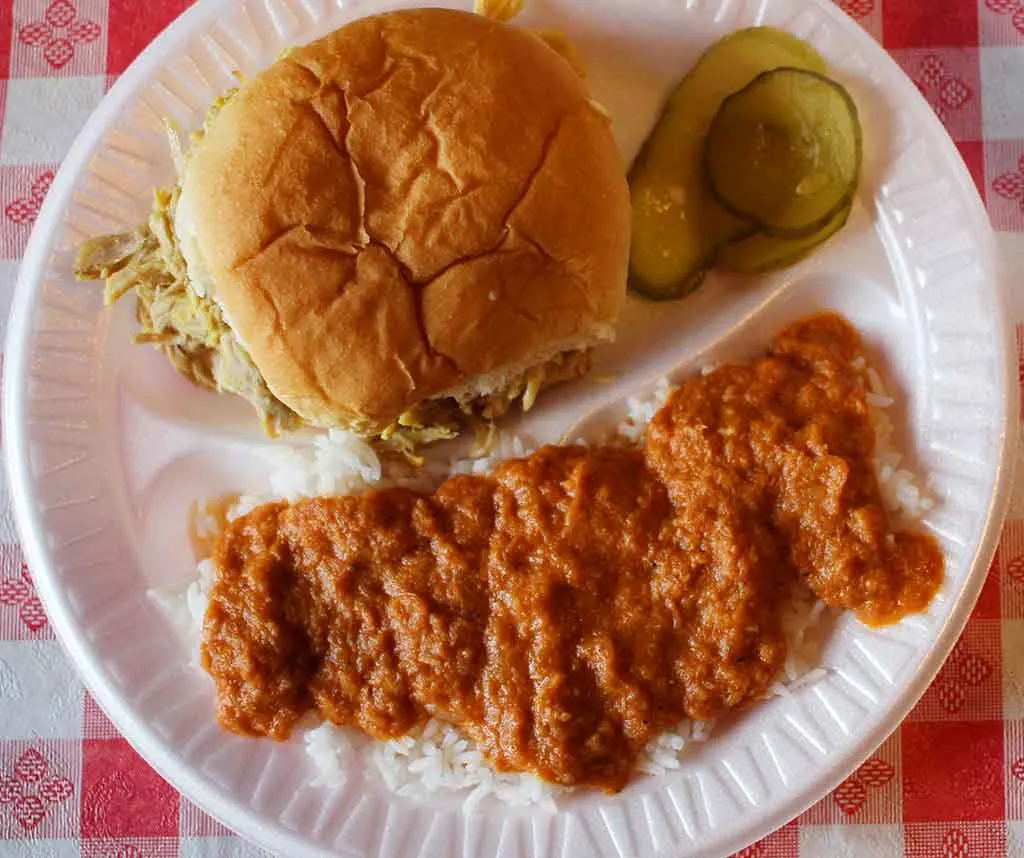
Simply put, traditional barbecue side dish amounts to a meat gravy. It’s most often served over white rice and remains a staple on BBQ menus across the state.
Ok, So What’s in It?
Well, the answer depends on where it is being made and, as always, on who is making it.
South Carolina is as diverse in its hash offerings as it is in its traditional sauce offerings. Check out this map of the areas where certain sauces have historically been served. Our favorite mustard-based barbecue sauce remains a signature delicacy, but unlike hash, it has found fame outside of the Palmetto State.
Map of South Carolina’s BBQ Sauce Regions

There is no such map for hash. Generally speaking, you would find different styles of hash offered in the three primary regions of the state.
“In the Midlands, hash is usually a mustard-based pork concoction, while the Lowcountry’s preference is pork spiked with a good bit of vinegar to complement the liver-forward flavor.
Beef with lots of onion – called “white hash” – is the hash of choice in the Upstate,” writes Libby Wiersema in Enjoy SC Barbecue with a Side of Hash.
While I generally agree with Libby’s statement, it doesn’t paint a complete picture.
Let’s not forget the “Red Hash” you will find at places like Ward’s in Sumter.
And I don’t consider the Pee Dee the Lowcountry. That is where you will find “Liver Hash.”
This hash variety is served in places like the Pope’s three barbecue restaurants in Florence mentioned above, or at Shuler’s BBQ in Latta or Big D’s in Hemingway.
The Liver Hash at Shuler’s BBQ

No matter where you enjoy your South Carolina BBQ hash, however, the basic recipe is the same. As Wiersema notes, “South Carolina hash is a stewlike concoction of ground meats flavored with vegetables, condiments, and spices.”
In the meantime, if you’d like to see a good hash being made, check out this video. Josh Allison of Big Red’s Barbecue walks you through the process of making a traditional hash in the Upstate style.
His recipe can be found in the “Recipes” section below.
Cooking Hash: Video

Like What We’re Doing?
Want to see more coverage and features? Just want to show your support?
Where can I find South Carolina BBQ Hash?
As of this writing, you can find hash on the menu of just over 50% of South Carolina’s BBQ restaurants. We have confirmed hash is on the menu at 160 of South Carolina’s 319 BBQ restaurants.
If you only count one restaurant from each of the restaurants with multiple locations, you will find that South Carolina has 112 distinct restaurant brands serving hash.
(See our South Carolina Barbecue hash map and directory.)
Check out the map below. Each marker shows the location of an restaurant in South Carolina serving hash as of Nov. 2019.
Every BBQ Restaurant Serving Hash in South Carolina
Below, you’ll find a map that shows all the barbecue joints in the Palmetto State serving our signature barbecue side, often along with chopped or pulled pork and our traditional mustard based sauce.
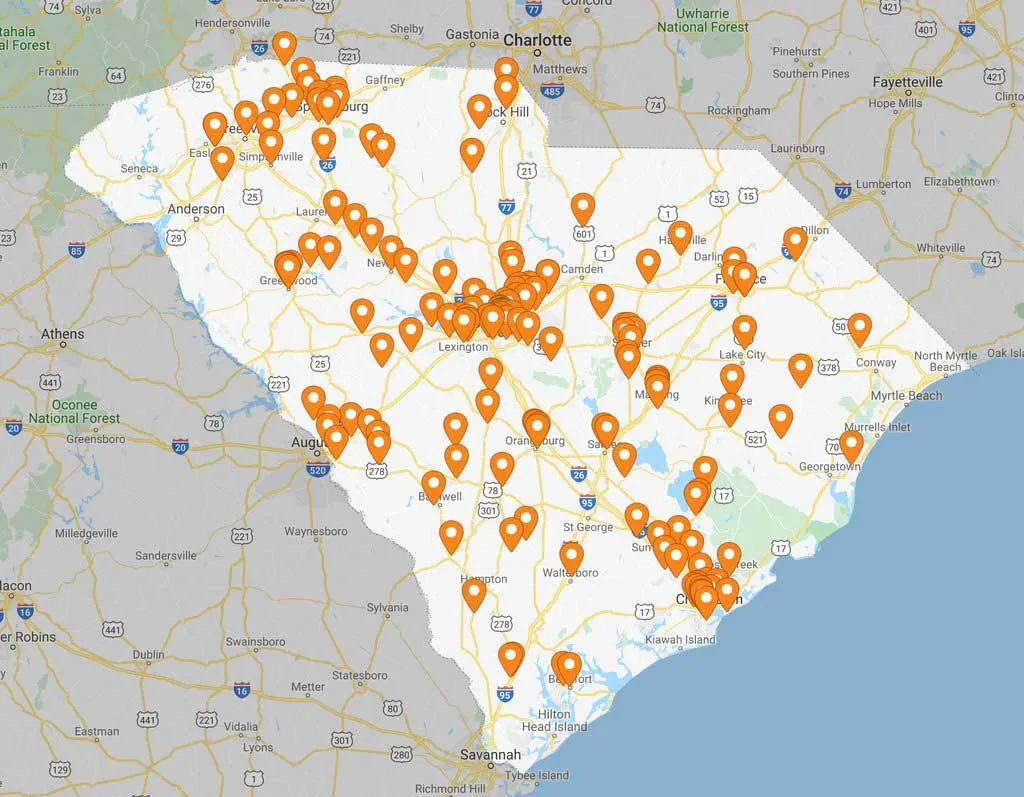
If you look closely, you may see some patterns emerge.
Clearly, I-26 is South Carolina’s BBQ hash corridor, with our signature side dish readily found from Charleston to the NC state line. Interestingly, I-95 doesn’t seem to share a similar distinction.
That said, Interstate 95 does cross through fewer population zones, and where it does, you can usually find hash.
Columbia seems to offer the most options. Keep in mind there are about a dozen Maurice’s in and around Columbia, but the Midlands obviously love their hash on rice.
There are also clear clusters in and around Charleston, Greenville-Spartanburg, and the North Augusta-Aiken area.
The Pee Dee
Sumter seems to stand out as having a number of hash options. However, that is mainly due to the four Ward’s locations currently serving the city.
On the other hand, Florence has only 4 restaurants serving South Carolina BBQ hash. Three of them — Roger’s, Woodstone, and The Flaming Pig — were all originally started by the same couple.
Roger and Sharon Pope, who now own only the latter. The Popes’ influence is clear as each of these restaurants serve the same basic hash recipe, a liver hash.
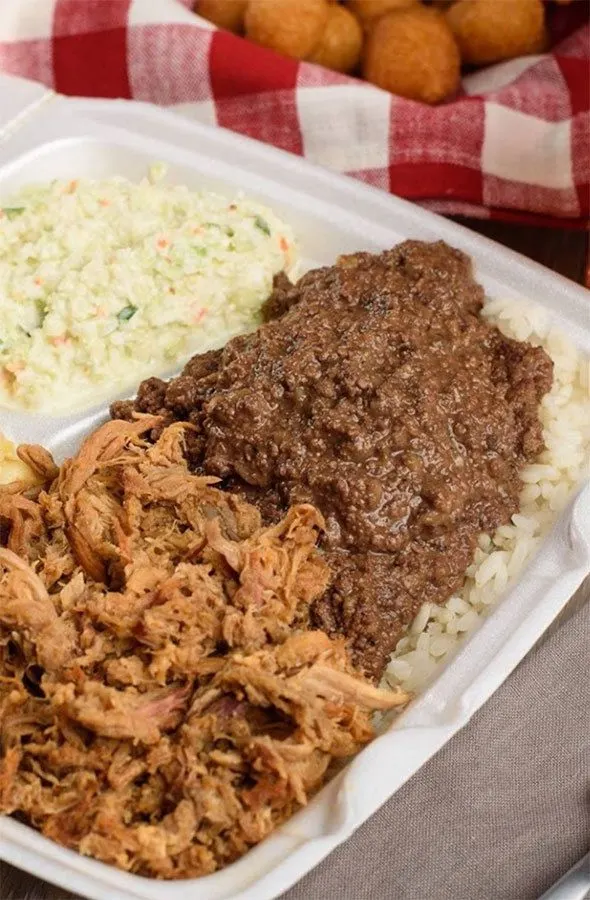
Taking that into account, hash, though readily available, seems to be merely scattered across the Pee Dee region, which comprises most of the northeastern quadrant of the state.
Given the region’s history of preferring whole-hog BBQ — which obviously uses the whole hog — maybe this is not too shocking.
Surprisingly, there is no hash to be found in Myrtle Beach, despite its draw as a tourist town. Then again, maybe that is the very reason why.
Despite the historic prevalence of the hash houses that once dotted the Upstate, you don’t see that today.
If you draw a somewhat diagonal imaginary line from south to north starting just west of Aiken and Columbia, you find hash is now more widely available in the middle and eastern part of the state.
The History of South Carolina BBQ Hash
So, how did South Carolina barbecue hash get started?
The story of hash mirrors the history of BBQ. Both have a strong tie to our past.
It looks like it may have found its beginnings in southwestern SC. And, apparently, we may have to share the origin story with our neighbors to the south.
Noted food writer and culinary historian Robert F. Moss, a native Sandlapper himself, is likely the most-studied person on the topic.
He wrote the following in an article for Eatocracy:
“Hash originated prior to the Civil War in the counties on either side of the Savannah River in South Carolina and Georgia.
“Estrella Jones, who was born into slavery on Powers Pond Place near Augusta, GA, recalled that when she was a child, the men would sometimes steal hogs from other plantations and ‘cook hash and rice and serve barbecue.’
“At the opening of the Civil War, a feast was held to honor the Edgefield (County, SC) Riflemen as they prepared to leave for battle. The menu included ‘barbecued meats and hash.’
“By the 1880s, hash was being served as far north as Newberry, SC, and as far south as Macon in central Georgia.
“Today, hash has all but disappeared in Georgia, which has become Brunswick stew territory. It continues to reign supreme as South Carolina’s barbecue accompaniment of choice.”
Outside of Robert Moss’ research, general theories vary. While there may be no definitive answer, there are three main ideas regarding its origin.
South Carolina BBQ Hash Born in Slavery?
One idea is that hash, like many dishes in the South, emerged from the darkness of slavery. According to some, enslaved people received the less desirable parts of the hog and used their culinary skills to turn them into something more edible.
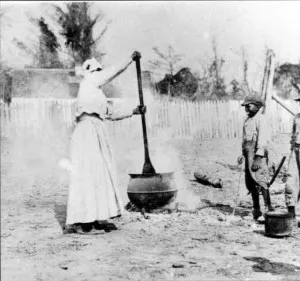
“At the same time on rice and indigo plantations enslaved populations began to expand and it became necessary to provide low-cost high nutrition meals,” writes Stan Woodward in Woodward on “Carolina Hash.”
“This set up the challenge for the cooks for these slave communities to be able to take the poorer parts of the hogs at hog-killing timepieces like the hog-head, ears, snouts, and innards – and find a way to make these palatable.
“The cooks combined African spices and seasonings and came up with the concoction we now call hash.”
Saddler Taylor, a folklorist writing about hash for scencyclopedia.org, concurs with Woodward.
“Some historians say the origins of hash can be traced to enslaved Africans who devised ways to make tasty dishes out of the undesirable ‘offal’ meats plantation owners wouldn’t eat.”
Hash from our German Immigrants?
Another theory holds that our German immigrants came to South Carolina with their own traditions. In fact, some contend this lineage is the origin of mustard-based barbecue sauce.
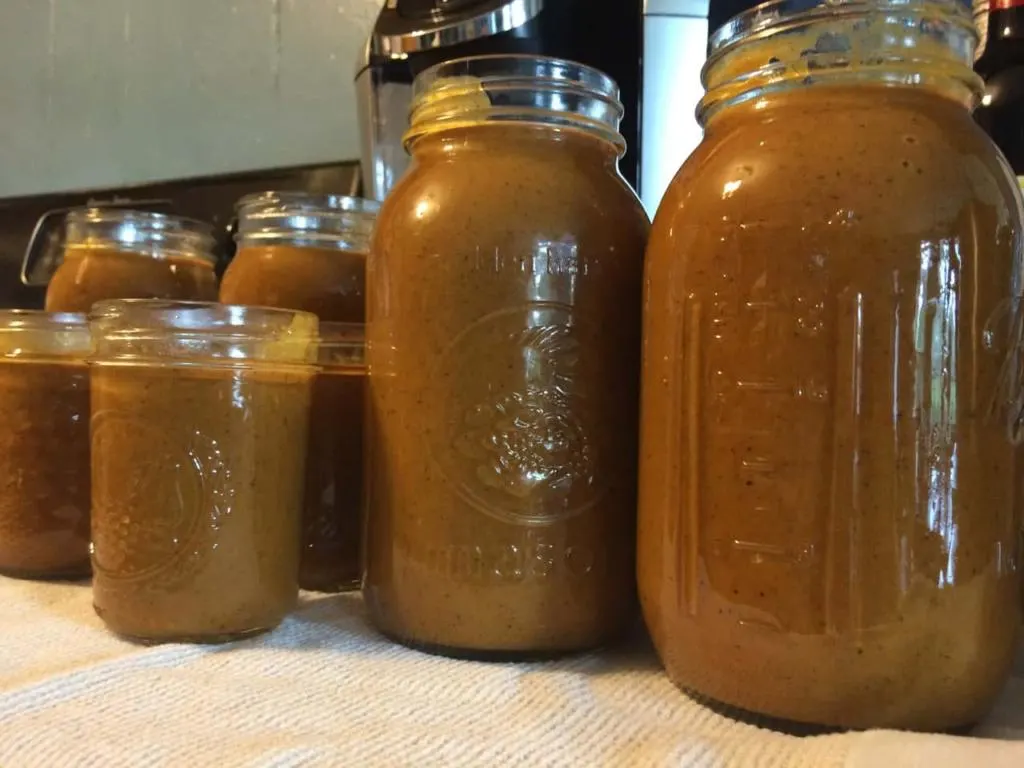
As it relates to South Carolina barbecue hash, however, Taylor brings up a cogent point.
“Other theories point to German settlers in the state who brought with them the tradition of grinding meat for gravy.”
That said, I could find no comparable dishes by doing a quick Google search.
In an interesting side note, Woodward reports an interesting angle.
“The name, ‘hash,’ is thought to be derived from the French Huguenot population in the city of Charleston.
“Pillsbury cited a letter sent back to family members from one such citizen of Charleston that mentioned having seen Negro cooks on the plantations cooking a hog stew made of many parts he called ‘hashiers’ similar to the stews cooked in his region of France.”
Hash for Frugality?
A third notion seems to be the most reasonable. People simply made hash as a way to avoid wasting parts of an animal they went to considerable effort (and expense) to raise.
South Carolina barbecue hash “seems to have originated as a way to use all of the pig slaughtered for a barbecue.” So writes Robert Moss in “South Carolina Hash: A Primer” on his website.
“In the early days, it was often referred to as ‘giblet hash’ or ‘liver and lights hash,’ reflecting the use of organ meats in the stew.”
However hash found its way to our tables, it makes yet another unique culinary contribution to the world of BBQ from our state.
South Carolina’s Hash Houses
As you have seen, BBQ joints serving this special dish spread far and wide across South Carolina.
However, we relegate hash to the level of side dish. Often, you will find a simmering cauldron of it slowly steaming on a buffet line.
You don’t find many honoring the dish via their name. In fact, a search of all the BBQ joints in our database yields only one return: Fat Daddy’s BBQ and Hash House in Cross Hill.
There is/was a place in Troy, SC, called The Hash House. It was open seasonally, but their last post on their Facebook page was in 2014.
Typical Hash House in the Lower Piedmont
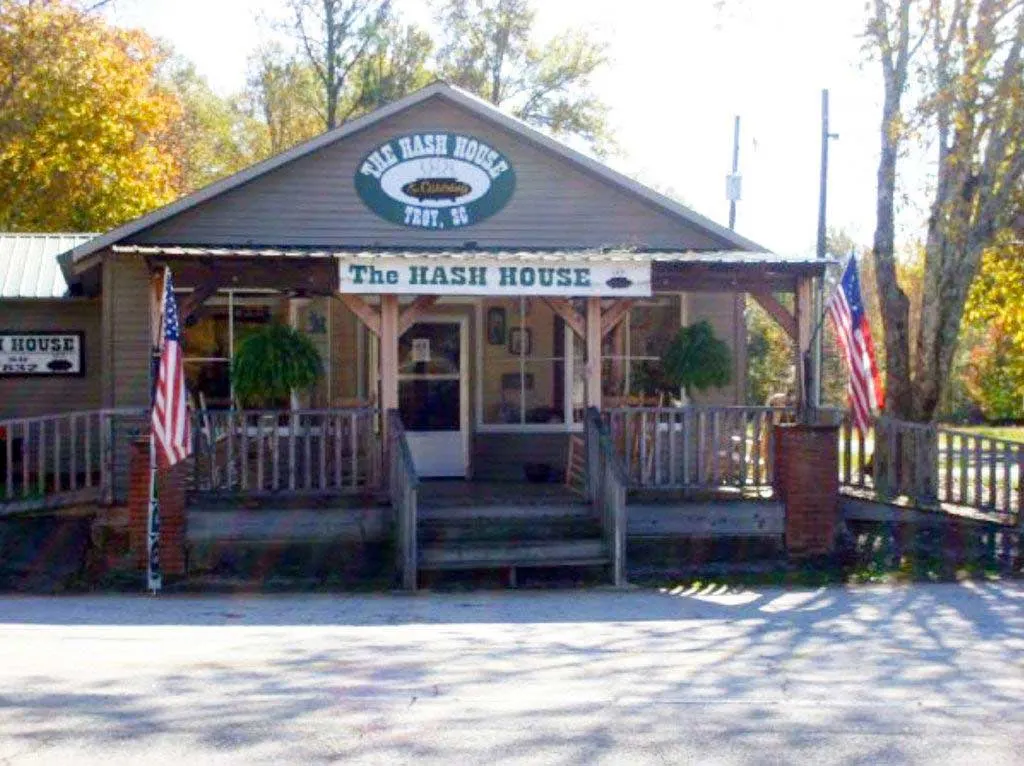
This house is very similar to one that Woodward refers to when he writes the following:
“Mrs. Dabney invited me to join her for lunch. On the way, knowing my interest in filmmaking, she told me she wanted to show me a most unusual place filled with local lore that was the most popular little eatery in Greenwood.
Colorful Character
“It was run by a character like none-other. A colorful and loquacious lady named Miss Ruth, who long had become the main attraction, along with her fabled hash, for her faithful customers from all stations of life in Greenwood.
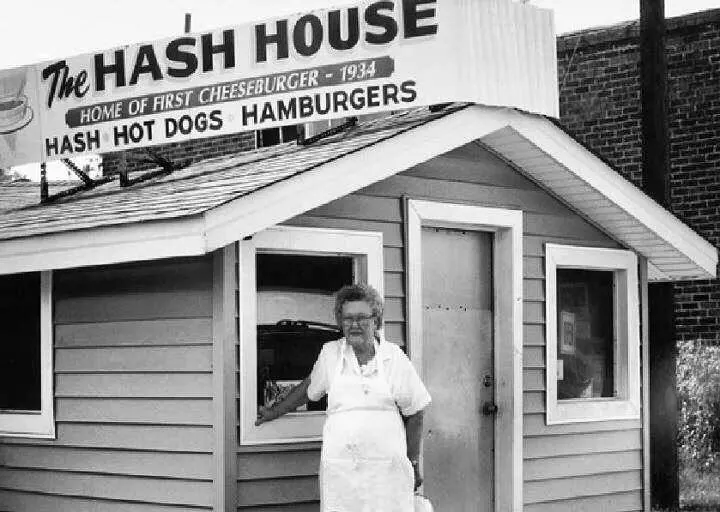
“We turned down a street that followed railroad tracks that came across a junction at the heart of Greenwood where a tiny little clapboard building stood not more than fifteen feet from the rails where mighty freight trains roared through at set hours during the day.
“The train engineers always sure to blow their horns and wave at Miss Ruth who stood at her window facing the tracks and waved back.
“The small building at first glance seemed too small to contain an eatery. But there on top of the roof stood a sign that said ‘The Hash House.’
“When I was introduced to Miss Ruth that day, I knew that I would return to shoot a short film about The Hash House.
“Little did I know that this would not only open the door to my discovery of how deeply and emotionally ingrained into South Carolina folk culture hash had become but that this documentary would also cause me to depart the Governor’s School.
“It would evolve into a folklife documentary video production partnership with McKissick Museum.”
Woodward’s partnership led to many important films documenting southern culture. Among them is this hour-long documentary about South Carolina barbecue hash.
Due to film rights, I am unable to embed the film here, but I encourage you to check it out. Below is sort of an unofficial trailer for the film, where you can meet Miss Ruth herself:
Meet Miss Ruth
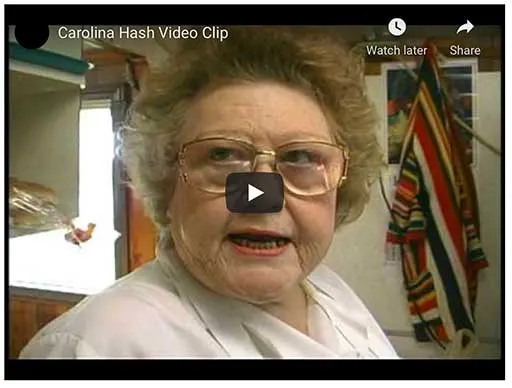
While times have changed, there was an era when “hash houses” were common across South Carolina, particularly in and around Greenwood.
“At one time, dedicated ‘hash houses’ peppered the state,” Wiersema writes. “The heaviest concentration was in the Upstate. They were established by textile mill owners interested in luring farmers to their towns.
Not only would the owners hold community “hash-cookings” on special occasions, but they permitted farming families to use the facilities to prepare their own hash.”
From the 1950s to the 1970s, hash houses were scattered about the state, particularly in the Lower Piedmont. Robert Moss points this out in Barbecue Lover’s the Carolinas.
By the mid-late 2000s they had faded with history, along with the textile industry that once fostered them.
As you can see in this old video from SCETV, the Grendel Mills Hash House had long since closed, but the ruins harken back to a richer era.
Remains of Another Day
Changing times had an impact, but that was not the only influence on South Carolina barbecue hash.
SC’s Department of Health and Environment Control (DHEC) began enforcing more stringent food preparation standards around this same era.
“Bailey Riser’s Hash House, which had been in operation since the early 1960s, used to sell hash on major holidays [and then only on the Fourth of July].
“He told Stan Woodward that he received a notice from DHEC informing him that that was the only day he could cook and sell hash.
“If he wanted to have more frequent operations, he would have to fully enclose his hash house and add a cement floor and running hot water.”
Riser was, of course, not the only hashmaster to receive such an edict.
Today, SC BBQ joints are among the few keeping this historic tradition alive.
South Carolina Barbecue Hash Recipes
So, what you’d prefer just to make a hash native South Carolinians will appreciate?
Well, that’s no simple process. Traditionally, making hash takes a lot of time and constant attention so the thick stew does not burn on the bottom of the hash pot.
Many folks actually use a wooden boat paddle when making large batches. And, well, you’ll need an 80 gallon (or so) cast iron kettle if you want to do it right.
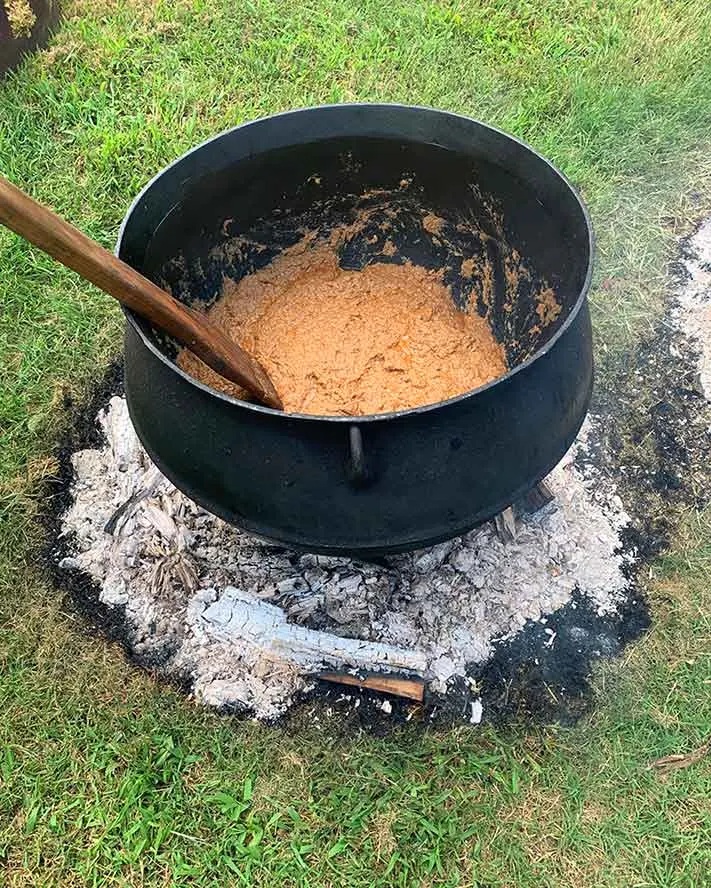
Of course, you’ll be doing that over the embers of oak and hickory. That’s just the way it has historically been done.
In fact, the recipe that David Bessinger of Melvin’s Legendary BBQ provided us for the second edition of our cookbook calls for the following meats:
- 6 Pork Hams
- Beef Chuck, 1 case
- Pork Kidneys, 1 case
- Pork Livers, 1 case
- Hog Jowls, 1 case
- 1 Beef Top Round
You need a huge kettle and wooden oar to stir such a mixture. Fortunately, we have original recipes for much smaller quantities with which you can use an immersion blender or food processor to make things easier.
Make Your Own South Carolina Barbecue Hash
Check out this recipe for Dukes Hash, which is rich in pork and potatoes.
If you’re looking for a standard beef hash recipe like the one in the video above, check out Orin Phillips’ Beef Hash recipe. It is in the style of what you once could find at the famous Willard’s BBQ in Gaffney.
Today, you might try the beef hash at Midway in Buffalo for a comparable product.
If you’d like to make Big Red’s hash shown above, the recipe is pasted below for your convenience.

Big Red's Beef Hash Recipe
Big Red's hash is a traditional dish of Upstate South Carolina. This is a high onion content hash with beef and some pork..
Ingredients
- 3 lbs beef stew meat
- 1.5 lbs pork (Boston butt/pork steak)
- 4 lbs yellow onion
- 2 tbsp salt
- 1 tbsp black pepper
- 1 tbsp red pepper flakes
- ¼ stick of butter
Notes
- Adjust the salt, pepper, and pepper flake to suit your taste.
Recommended Products
As an Amazon Associate and member of other affiliate programs, I earn from qualifying purchases.
Nutrition Information
Yield 20 Serving Size 8 ouncesAmount Per Serving Calories 263Total Fat 11gSaturated Fat 4gTrans Fat 0gUnsaturated Fat 6gCholesterol 100mgSodium 775mgCarbohydrates 10gFiber 1gSugar 4gProtein 32g
You may also be interested in this generations-old reader-submitted recipe that we published a few years back.
The Aull family hails from the Pomaria area, between Newberry and Columbia on 176. They have been cooking hash for Thanksgiving (yes, Thanksgiving) for almost 100 years.
We were honored to publish it here. Enjoy the Aull Family Hash, a real comfort food recipe.
Enjoy!
See our South Carolina BBQ Cookbook for a wide range of SC BBQ recipes, including even more hash recipes.
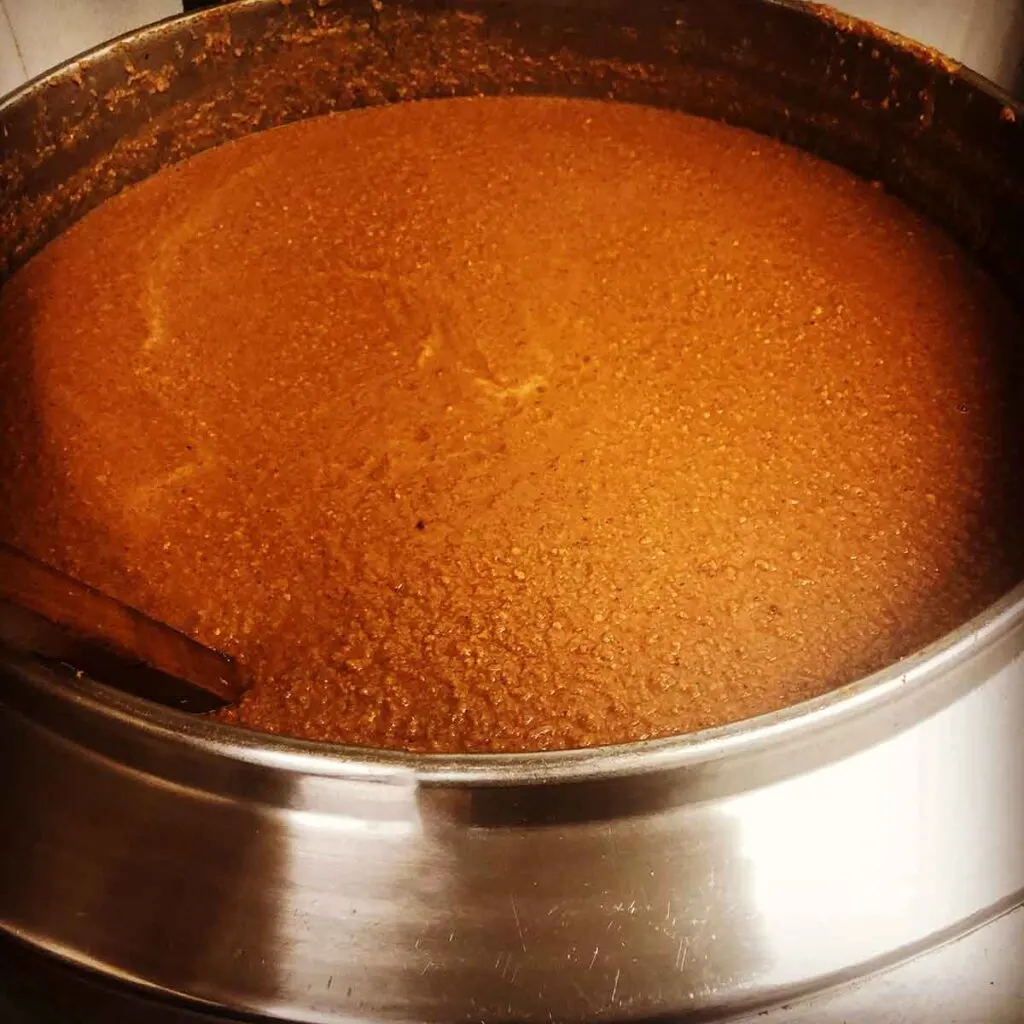
Panel Discussion on SC BBQ Hash
Finally, if you’re looking for even more info on South Carolina barbecue hash, this will be a treat.
Two of the most renowned experts on the subject, Robert Moss and Stan Woodward hosted a panel discussion. Together, they explore the history of South Carolina hash during the 2017 Festival of Discovery in Greenwood.
Now, sit back and relax; this is a good one.




